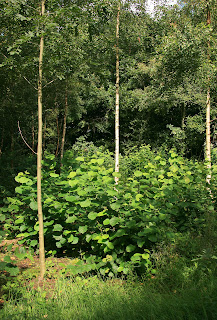
Some of you may remember coppicing Hazel and Ash, on Ivy Green, on the 18th November last year? Well, the other day I thought that I would stroll over to the site and see what had happened in the intervening 10 months or so. I was quite amazed by what I saw - some of the Hazel, which was cut almost to ground level in November, has produced shoots 6 ft high in just that short time! Of course, these shoots are still quite thin and whippy - but I'm sure that they will thicken up in the next year or two.

Our ancestors were well aware of this propensity of many of our broad leaved trees to sprout from the base when cut down. Coppicing is a practice which dates back at least to the Bronze Age (around 5 - 6,000 years ago) and is probably even older. In 'traditionally' wet parts of the country - like the Fens or the Somerset Levels - archeologists have found trackways, and other structures, buried and preserved in peat deposits. Examination of these remains reveals that they were originally constructed from coppice poles.
Right up until the early years of the 20th Century coppice poles had many uses including: wattle and daub walls, hurdle-type fence panels, tool handles and anything which required long straight poles. Coppiced wood was also turned into charcoal by heating it in the absence of air. Perhaps the most sophisticated use for coppice poles was found around High Wycombe, in Buckinghamshire, where craftsmen, working on pedal-driven pole lathes, in the open air, produced high quality furniture components (chair legs etc.).
Coppicing is a good environmental practice because it lets light onto the woodland floor and allows other plant species to flourish - thus boosting the biodiversity of the site. It also, and this may seem paradoxical, prolongs the lives of the coppiced trees (some coppiced Ash stools may be some of the oldest living things in the country).
If you are interested in coppicing or, or woodlands in general, you might like to read the following books:
'Woodlands' by Oliver Rackham (Collins, 2006)
'Seahenge' by Francis Pryor (HarperCollins, 2001)
'Wildwood: A Journey Through Trees' by Roger Deakin (Penguin Books, 2007)
Dave Bishop, 31.08.2008



No comments:
Post a Comment